Jazz fusion has all the acceptance of plague-ridden rats. Dare to speak the word ‘fusion’ and you’re most likely to get laughed at, frowned upon, or spit at, maybe all three if you’re really lucky; yet it’s hard not to maim the genre’s champions. Fusion was pretentious; its fans claimed the players were virtuosos and deemed most other music unworthy to their ears, while the sounds produced by the aggrupation of fleet-fingered soloists were mostly bland, overplayed, and highly unlistenable to anybody who didn’t own at least three books on modal harmony. Worst of all, fusion was often clawless, aiming for musical acceptance of ‘sophisticated’ listeners within the rock spectra, the musos and proggers enthralled by Ian Anderson’s labyrinthine compositions and Rick Wakeman’s sonatas in Moog-minor. It was probably the first style to be marketed as ‘Adult Contemporary.’
The (arguably) first jazz fusion band, however, wasn’t about getting people to strike their beards together in appreciation; in fact, they were all about melding the newly electrified hard-bop’s sensibilities (spewing horns aloft and drummers freaking) with the fire and orgasm of rock improvisation, started by the likes of The Who and The Yardbirds and brought to celestial heights and popularity by Jimi Hendrix. At least that was John McLaughlin’s goal when he formed the Mahavishnu Orchestra, a goal that got plastered all over their two albums in their original incarnation. As their name suggests, Mahavishnu’s sound was heavily influenced by classic Indian music, not so much through structures and drone, but rather with the tonalities of mood music, represented on The Inner Mounting Flame (1971) and Birds of Fire (1973), in which the guitar, violin, and keyboards would take turns tackling highly electrified passages of intricate melodic lines, only to give way to more atmospheric patches or dissolve into a mutating riff. All the while, the bass and drums would perform an ever-changing rhythmic foundation. The Mahavishnus created sounds informed by the spirituality of a place where every part of the day requires a different kind of music and, therefore, saturates the actual time and place of life at that point. The span between Inner Mounting Flame and Birds of Fire was one of those rare instances in modern times where virtuosic music could sound amazing to non-musician ears, giving off feelings and moods to enjoy rather than to ponder; it was intellectual music for the heart and soul.
Sadly, the Mahavishnu Orchestra were virtually alone in sound and purpose, as most fusion bands could or would not tap into such emotional territory, let alone into truly experimental zones that would require a bit of fear and recklessness. Most of their contemporaries were out for the glory and the quick buck, leaving them virtually peerless; although, after the exit of violinist Jerry Goodman and drummer Billy Cobham, the Orchestra would settle for more sedated pastures, leaving behind their signature vibe and shutting the door on an exciting avenue that could have gone on to achieve a Valhalla of possibilities.
Yet, those sounds regained a new life in, of all places, a death metal band.
Out of the waves of extreme bands in the late 80s and early 90s metal underground, only a few would take death metal, already a very technically subgenre , to new heights — with sheer playing ability delivering some of the most intrinsic and virtuosic music in the world. Bands like the pioneering Death, Atheist, Gorguts, and Pestilence would bring out prog rock structures to blastbeats and deep-growling to make for the sickest and most refined music, as odd a combination this might seem to the uninitiated.
Of all the pioneering death metal bands, Cynic showed a very peculiar style that stood out, even amidst their superhuman-fingered counter parts in knotty gore metal. They displayed a level of sophistication and execution few could reach, using exotic interval-leaping scales without sacrificing double-bass drum sections and ultra heavy riffing. Their album Focus (1993) is the closest, in my opinion, the world has seen to an album by the original Mahavishnu Orchestra (without trying to rip them off), making an old sensibility something truly their own. At a superficial level, Focus doesn’t sound like something McLaughlin could have made, but listening to the mood, the melodies, the arrangements, and the quiet, arpeggiated sections that invade every corner of the record, you’ll find yourself in familiar territory.
Although Cynic might not have been the only death metal band to reference jazz fusion in an exciting way, Focus remains a sadly under-appreciated album, with plenty of beauty, brutality, complexity, and grounded songwriting holding it together. And to prove the connection, take a listen to a song by MO and one from Cynic’s magnum opus.
-
-
-
I saw Cynic earlier this year, playing an all-day metal fest, and they remain the only death metal band who could get people in the audience to do yoga with them. How many headbangers can pull that off without getting killed by the crowd?
It is exciting to track a mutating sound over time — a form that drifted over the airwaves, picking up jazz, rock, and Eastern sensibilities, only to take the form of death metal decades later. The amount of distortion or double-bass in the music doesn’t really matter. The feelings it evokes does, and how connected it can make you feel if it speaks to you. In the end, that’s the real concern for the true listener, even if you hate Mahavishnu Orchestra and/or Cynic as much as the average music snob hates jazz fusion.
